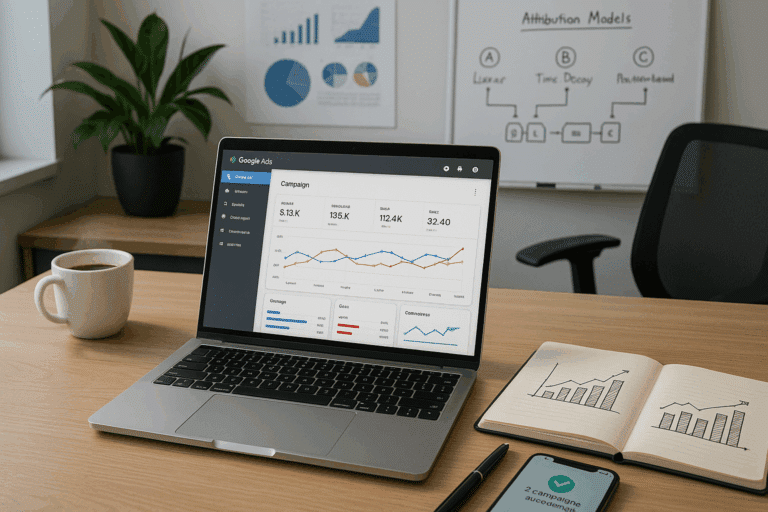These two phrases are more than just buzzwords in the marketing industry. They’re the key to unlocking significant growth in your Return on Investment (ROI) 🔑. Today, we’re going to explore how.
As a digital marketer, you understand that leveraging Facebook Ads can be an effective strategy for reaching your target audience and driving conversions. But are you getting the maximum possible ROI? Are your current attribution models giving you the full picture? Or are they leaving you in the dark about the true effectiveness of your campaigns?
Enter the world of custom attribution for Facebook Ads 🌍. This powerful tool can help you shed light on the hidden aspects of your campaigns, allowing you to optimize your ad spend and boost your ROI to new heights.
What is Custom Attribution, Anyway?
Before we dive deep into the specifics, let’s take a brief moment to understand what custom attribution is. In the simplest terms, custom attribution is a way to assign credit to different marketing touchpoints within your customer’s journey. It provides a clearer, more detailed view of your campaign performance, helping you to identify what’s working, what isn’t, and where your marketing dollars are having the most impact.
Why Should You Care About Custom Attribution for Facebook Ads?
Traditional attribution models often fall short when it comes to capturing the true impact of your Facebook ads. They tend to oversimplify the customer journey, failing to account for the various touchpoints that influence a customer’s decision to convert. This can lead to inaccurate assessments of your campaigns and missed opportunities for optimization.
Custom attribution offers a solution to this problem, providing a more holistic view of your marketing efforts. It enables you to track and analyze every touchpoint, from the first ad click to the final conversion. With this comprehensive insight, you can make more informed decisions about your ad spend, resulting in a more effective marketing strategy and a higher ROI 💰.
What Will We Explore in This Article?
Over the course of this article, we’ll be delving into the nuts and bolts of custom attribution for Facebook Ads. We’ll start with an overview of how Facebook’s attribution works, including its limitations and how custom attribution can address them.
From there, we’ll walk you through the process of setting up your own custom attribution model, with step-by-step instructions and expert tips to ensure you’re getting the most out of your efforts.
We’ll also provide real-life examples of how businesses have used custom attribution to optimize their Facebook ad campaigns, along with actionable insights you can apply to your own strategy.
Finally, we’ll wrap up with a discussion on the future of custom attribution, looking at how advancements in technology and shifts in consumer behavior are shaping this field, and what it means for your marketing strategy moving forward 🚀.
Whether you’re a seasoned digital marketer or just starting to explore the potential of Facebook Ads, this guide is designed to equip you with the knowledge and tools you need to maximize your ROI through custom attribution. So, let’s dive in and unleash the power of custom attribution for your Facebook Ads.
Understand the Essence of Custom Attribution
In today’s digital era, it’s no longer enough to just run ads and hope for the best. Businesses need to ensure that their advertising strategies are data-driven and results-oriented. One tool that is reshaping the way businesses track and optimize their ad campaigns is custom attribution. But what exactly is it, and how does it work?
Custom attribution is a method of tracking the performance of advertising campaigns by assigning credit to different touchpoints in the customer’s journey. Unlike traditional attribution models that assign all the credit to the last touchpoint before conversion (last-click attribution), custom attribution takes into account all the different interactions a customer has with a brand before making a purchase.
By understanding the role each touchpoint plays in the conversion process, businesses can allocate their advertising budget more effectively and maximize their return on investment (ROI). This becomes particularly significant when managing Facebook Ads, a platform that offers detailed targeting options and generates valuable user interaction data.
Custom Attribution and Facebook Ads: A Powerful Combo
Facebook Ads provides a fertile ground for implementing custom attribution due to its inherent capacity for tracking user engagement. With a diverse range of ad types and an extensive audience reach, Facebook Ads offers multiple touchpoints that can influence a customer’s decision to purchase.
Moreover, Facebook’s built-in analytics tools offer granular data on ad performance, including click-through rates, conversions, and user demographics. By utilizing custom attribution, you can leverage this data to gain insights into which ads and touchpoints are driving the most conversions and optimize your campaign accordingly.
For example, you may find that your video ads are generating a lot of engagement, but it’s actually your carousel ads that are driving the most conversions. With this information, you could decide to allocate more of your budget to carousel ads to boost your ROI.
Setting up Custom Attribution for Facebook Ads
To set up custom attribution for your Facebook Ads, you’ll need to use the Facebook Ads Manager. Here, you can choose the attribution model that best fits your business needs and goals.
You can also set up custom conversion events to track specific actions that users take on your website, such as filling out a form or making a purchase. These events can then be used as touchpoints in your custom attribution model.
It’s worth noting that setting up custom attribution requires a deep understanding of your business and your customers’ journey. Therefore, it’s often recommended to work with a digital marketing professional or agency that specializes in custom attribution.
Comparing Custom Attribution with Other Attribution Models
Understanding the differences between custom attribution and other attribution models is key to realizing its potential in enhancing your Facebook Ads ROI. Let’s take a look at some common attribution models and how they compare to custom attribution.
| Attribution Model | Description | Advantages | Disadvantages |
| Last-Click Attribution | Assigns all credit to the last touchpoint before conversion. | Simple and easy to understand. | Overlooks the impact of earlier touchpoints. |
| First-Click Attribution | Assigns all credit to the first touchpoint in the customer’s journey. | Highlights the importance of awareness stage touchpoints. | Fails to consider the role of later touchpoints. |
| Linear Attribution | Equally distributes credit among all touchpoints in the customer’s journey. | Acknowledges the contribution of all touchpoints. | May overvalue less impactful touchpoints. |
| Custom Attribution | Assigns credit to touchpoints based on custom rules and weightings. | Flexible and can be tailored to reflect the customer’s journey accurately. | Requires detailed data and advanced analytical skills. |
Boost Your ROI with Advanced Insights from Custom Attribution
As the digital advertising landscape becomes increasingly complex, businesses need more sophisticated tools to navigate it successfully. Custom attribution provides the deep insights and flexibility needed to optimize your Facebook Ads and maximize your ROI.
By understanding the unique contribution of each touchpoint in the customer’s journey, you can allocate your advertising budget more efficiently, improve your campaign performance, and ultimately, achieve better results. So, are you ready to unleash the power of custom attribution for your Facebook Ads?
For a visual guide on setting up custom attribution for Facebook Ads, check out the video “Facebook Ads Custom Attribution Setup Tutorial” on the Surfside PPC YouTube channel. It provides a step-by-step walkthrough on creating custom conversions and setting up attribution models in Facebook Ads Manager. Don’t forget to like and subscribe for more informative videos!
Conclusion
Custom attribution is a powerful tool that can revolutionize your Facebook Ads strategy. By harnessing the power of detailed data and advanced analytics, you can gain a deeper understanding of your customer’s journey and optimize your ads for maximum ROI. The future of advertising is here, and it’s time to embrace it.

Conclusion
In conclusion, the topics covered in this article reflect the critical dimensions of the technological world, especially in areas like IT and Engineering. Through the lens of my experience and expertise, I have striven to provide an insightful and comprehensive exploration of these complex concepts.
To recap, we began with an exploration of the latest trends and advancements in software engineering, underscoring the transformative role of technologies such as artificial intelligence, machine learning, and big data in reshaping our digital landscape. We discussed the increasing importance of cybersecurity in our interconnected world and how businesses must prioritize security measures to protect their digital assets and sensitive data.
We dove deep into the intricacies of coding and software development, shedding light on the essential role that high-quality code plays in ensuring software efficiency, functionality, and security. We discussed the various programming languages, their unique features, and how they can be effectively utilized in different projects.
We also discussed cloud computing and its many benefits, including scalability, cost-efficiency, and easy access to high-powered computing resources. We looked at different cloud service models, including IaaS, PaaS, and SaaS, each with its unique benefits and considerations.
The world of IT and engineering is indeed vast and complex, but I hope that this article has been able to simplify some of the complexities and spark your curiosity and interest in these topics. They are integral to our digital lives, and understanding them can help us make better, more informed decisions, whether we are software engineers, IT professionals, or simply tech enthusiasts.
As we continue to navigate through the digital age, let’s keep our minds open, eager to learn, adapt, and innovate. I invite you to share your thoughts, ideas, and experiences in the comment section below. Feel free to share this article with others who might find it useful or interesting.
Whether you’re a seasoned professional looking to stay up-to-date with the latest trends, or a beginner eager to learn, I hope this article has provided you with valuable insights. Remember, knowledge is power, and sharing it helps us all grow. So, if you’ve found this article useful, don’t hesitate to pass it on! 💡
For further reading, I recommend the following resources:
– IBM Cloud Computing
– Microsoft Cybersecurity
– Google Developers
I look forward to hearing your thoughts and continuing the conversation in future articles.
Thank you for reading, and as always, keep innovating and pushing the boundaries of what’s possible! 🚀
References:
1. IBM Cloud. Cloud Computing. Available at: https://www.ibm.com/cloud/learn/cloud-computing
2. Microsoft. Cybersecurity. Available at: https://www.microsoft.com/en-us/cybersecurity
3. Google Developers. Available at: https://developers.google.com/



